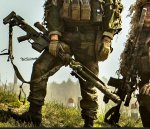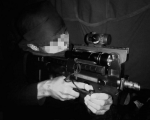Yeh dekhiye birathers,
nayi umang,
nayi asha,
naya naya hai yeh chutiyapa.
Sniper rifles for Indian Army delayed as 20 firms offer weapon, but none make ammunition
Indian Army is now looking to scrap the RFI and start afresh its hunt for 5,700 high-precision sniper rifles, at an estimated cost of Rs 982 crore.
Amrita Nayak Dutta, Updated: 17 June, 2019 11:39 am IST
A sniper rifle produced by Steelcore Designs (representational image) | Steelcore Designs
New Delhi: The Indian Army’s wait for much-needed
sniper rifles just got longer, with the procurement process hitting a glitch: 20 firms replied to the Army’s request for information (RFI), floated last year, but none of them manufacture the ammunition.
The absence of ammunition-manufacturing capacity is seen as a major drawback because the
Army was looking to secure technology transfer under the final deal for the seamless operation of the rifles in the long run, ThePrint has learnt.
The Army is now looking to scrap the RFI and start afresh its hunt for 5,700 high-precision sniper rifles, at an estimated cost of Rs 982 crore, highly-placed sources in the defence establishment told ThePrint.
The possible options for a new procurement process include floating two separate RFIs — one for procuring sniper rifles and the other for ammunition, the sources said.
“Or the existing RFI could be tweaked to include a clause that the interested firms should manufacture ammunition as well, and also subsequently transfer the technology to India,” a top Army source said, adding that a final decision on the matter is yet to be taken.
Only once this stage is finalised will the Army issue a request for proposal (RFP), the second stage in such transactions, detailing the specifications required.
The transfer of technology question
In February last year, the Defence Acquisition Council approved the purchase of sniper rifles for the Army and the Indian Air Force at an estimated cost of Rs 982 crore.
“While these high-precision weapons will be bought with ‘Buy Global’ categorisation, their ammunition will be initially procured and subsequently manufactured in India,” the Defence Ministry said in a statement issued last year.
There were 12-13 foreign firms among the 20 that replied to the 2018 RFI, ThePrint has learnt, with the respondents including Sako of Finland, H-S Precision of the US, Steelcore Designs Limited of the UK, PGM Precision of France, and Punj Lloyd Raksha Systems, a joint venture between Indian defence conglomerate Punj Lloyd and Israel Weapons Industries.
Also read: Indian Army deploys US-, Italy-trained snipers with deadly new rifles along LoC
However, after evaluating the firms, the authorities found that none had the capability to manufacture the ammunition.
“Ammunition is a crucial requirement for sniper rifles, because even if the firms procured ammunition from elsewhere later, they would not be able to transfer the technology to India,” another Army source told ThePrint.
‘Much delay unlikely’
The Army is looking to procure sniper rifles amid an increased threat of sniper attacks along the Line of Control as well as to seek a tactical advantage over enemies sighted at a distance.
While procurement of defence equipment is usually a long-drawn process, with multiple steps and thorough evaluations, sources in the defence establishment said that the purchase of high-precision sniper rifles was part of a modernisation plan and unlikely to face much delay.
“The troops are being provided with sniper rifles at the borders. This one is for the entire forces and will take the minimum standard time,” one of the aforementioned Army sources said. “The first batch will be delivered after two years.”
With the larger procurement taking time, the Northern Army Commander made an
urgent purchase this March of two new advanced sniper rifles — Barrett M95 .50 BMG and Beretta Scorpio TGT ‘Victrix’, with .338 Lapua Magnum cartridges — through his special financial powers.
However, the numbers procured were a blip compared to those required.
Explaining the significance of
sniper rifles, a senior Army officer said the long-range weapon equipped with a telescopic sight can be used to cause substantial damage to the enemy and demoralise them. They can also be used in counter-terror operations to eliminate top terror commanders while staying in stealth, the officer added.
“Sniper attacks are characterised by surprise and provide an element of anonymity,” the official added. “The enemy or an important target can be hit in a single shot, but such firing requires extreme stability and patience for hours together.”
“Sniper rifles can be used to inflict casualties without escalating the conflict,” the official said.
The difference between a standard rifle and a sniper rifle is the precision, with the latter having a small error margin.
Also read: Indian Army’s new sniper rifle paired with old improvisation tactics will turn tables at LoC
Since the 1990s, the Army has been using the Soviet-era Dragunov sniper rifle of 1963 vintage, which uses a 7.62×54 mm rimmed cartridge and has a range of 600 to 800 metres. However, the focus has since shifted to night vision and better accuracy.
The RFI issued by the Army’s Infantry Directorate in 2018 took into account these factors, seeking 8.6X70 mm sniper rifles with a range of at least 1,200 metres, and 10.2 million rounds of ammunition.
Sniper rifles for Indian Army delayed as 20 firms offer weapon, but none make ammunition









 . I still have connections to the military, have seen opportunities to travel to various hot spots including Mali and Afghanistan, but am not part of my nation's armed forces at this time. I recently moved on from a comfy job as a programmer for a defence contractor.
. I still have connections to the military, have seen opportunities to travel to various hot spots including Mali and Afghanistan, but am not part of my nation's armed forces at this time. I recently moved on from a comfy job as a programmer for a defence contractor.





















 .
.
 .
. .
.

